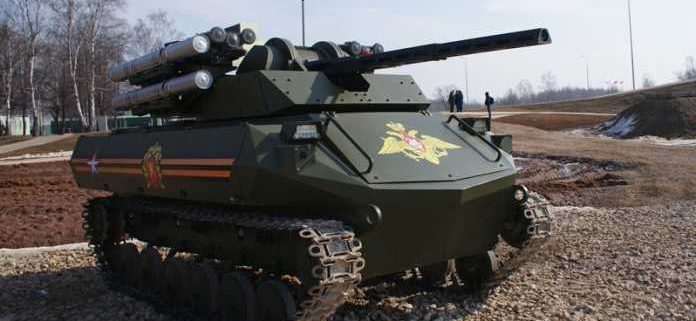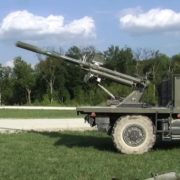Check out the video below of Uran-9, the new Russian unmanned armored vehicle.
Pretty impressive, isn’t it? This thing packs:
- 30mm 2A72 automatic cannon
- Coaxial 7.62mm machine gun
- Ataka Anti-Tank Guided Missiles
According to Defense Talk, it has “a laser warning system and target detection, identification and tracking equipment.”
Russia has big plans to promote Uran-9 in the international market where it “…will be particularly useful during local military and counter-terror operations, including those in cities.”
Not to be too much of a wet blanket, but why would anyone buy this? Russia says that it will reduce personnel casualties, one of the prime benefits of unmanned systems. I wonder if this is true. For one thing, the remote operators are located in a mobile command unit. Is that safer than an armored vehicle? Is the operating range so great that the remote operators are significantly out of harm’s way?
For Russia’s target market, how significant are personnel casualties? The US is obviously not going to buy it (for one thing the American version would be called UranUS and yes, I wrote this whole article so I could use this joke). America pours a lot of money into its soldiers, so that they are the most expensive piece of equipment on any given battlefield. Other countries also invest a lot in their soldiers, but none do as much as the US. I bet for many countries, the loss of an armored vehicle is more expensive than the personnel casualties. I realize that this sounds cold blooded, but as commanders decide where to commit their limited resources, they will do these calculations. Will they want to pay more for a system that has a greater number of points of failure?
Furthermore, there is a good chance that there will be no cost savings for personnel, even if an operator could drive multiple vehicles. The installation and maintenance of the mobile command center as well as the remote control systems themselves will require highly trained personnel.
Also, what will be the situational awareness of the remote operator as compared to one actually inside the vehicle? As a rule, remote operators have less. Will that leave the vehicle more vulnerable?
Of course, my doubts may be completely unfounded, and this thing may sell better than iPhones. But I can’t help feeling that this vehicle was designed not for practical reasons, but because somebody somewhere thought unmanned systems were cool.
I asked Richard Barrios, ex-Marine Ammo tech and aficionado of all things that go BOOM, to take a look at the video. He agreed that the ordinance was impressive, but pointed out that the Geneva Convention prohibited these particular weapons from being used on personnel (as opposed to tanks and similar platforms). This puts a crimp in Russia’s assertion that this is a counter-terrorist weapon. Richard and I agreed that Russia and its clients probably will not care about this particular problem.
Richard suggested that this might be a good defense vehicle for a base. I countered that there were cheaper and more practical alternatives. Richard agreed and said that he preferred Precision Remote’s .50 caliber M2 remote-controlled solution (see video here). BTW, in the video you can see the ROCKY DK Rugged Tablet being used as a control unit for this .50 caliber solution.
Richard likes the Russian armored UGV, but like me, he harbors doubts about the usefulness of this platform as compared to a manned one. “I wouldn’t want to take it to war,” he said. “But I would want it as a toy.”









